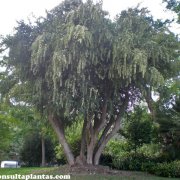Care of the tree Bursaria spinosa or Sweet Bursaria |
|
The genus Bursaria, family Pittosporaceae, comprises 7 species of trees and shrubs native to Australia. Some species are: Bursaria spinosa, Bursaria occidentalis, Bursaria tenuifolia. Common names: Sweet Bursaria, Blackthorn, Tasmanian Christmas bush, Mock orange. They are fast-growing trees or shrubs with thorny stems that reach 10 meters (32.8 feet) in height. They have obovate leaves with a serrated edge and an intense green color. The scented and abundant flowers appear in hanging clusters and are cream or white in color. They bloom from late spring to mid-summer. The fruits are capsules in the form of a bag. Sweet Bursaria is used as isolated specimens, to form barriers against the wind, in poor areas of the garden or to fix sandy slopes. It's ideal for Mediterranean coastal gardens. It attracts butterflies and bees. Bursaria spinosa can be grown in full sun or semi-shade exposures; it resists light and occasional frosts. Tasmanian Christmas bush prefers well-drained sandy soils that contain organic matter; they can also grow in poor soils. Water regularly, waiting for the soil to dry out. Blackthorn does not need fertilization. Prune after flowering to maintain a compact appearance. Also prune the suckers that sprout from their roots to control their expansion. Bursaria spinosa is a plant resistant to pests and diseases. Mock orange propagates by seeds sown in spring or by semi-woody cuttings. |
Images of the tree Bursaria spinosa or Sweet Bursaria |
Find plants
Bursaria spinosa or Sweet Bursaria | Care and Growing
© 2025 FavThemes



